I have visited Greenpoint a great deal for FNY pages, and have conducted two FNY tours in the Garden Spot of Brooklyn over 15 years. My last major survey, though, happened in 2005, almost 10 years ago! There have been plenty of other pages devoted to Eckford, Milton and Noble Streets and the shop signage on Manhattan Avenue (search FNY for those). This new initiative rambles to Greenpoint’s eastern and southeastern regions: I have not yet done anything substantial in that part of Greenpoint except for a couple of things here and there. Also, the neighborhood layout will be changing over the next decade as a new Kosciuszko Bridge will be built to replace the current one that opened in 1939. I have heard a 2017 completion date, but that’s obviously not going to happen and my estimate is 2025 or so, when I’ll be 68. Still alive and ambulatory, I hope.
At the end of Part 2, I had reached Cooper Park and the former Greenpoint Hospital. To complete my walk I meandered west on Orient Avenue, south on Bushwick Avenue and then staggered west to the Broadway G train station, where you can get a train connecting to the #7 train in Hunters Point, though that’s not always the case.
GOOGLE MAP: Greenpoint and East Williamsburg

Decades ago, Orient Avenue ran from Metropolitan avenue all the way to Newtown Creek, but is today confined to a one-block stretch as far east as the intersection of Olive and Sharon Streets and Cooper Park. The street contains a number of handsome dwellings and used to be known as Greenpoint’s “Doctor’s Row” as many of the physicians associated with Greenpoint Hospital resided here.
There is also an Oriental Boulevard in Brooklyn, several miles south in Manhattan Beach. “Oriental” means “east, as “occidental” means west. The Oriental Hotel was one of a series of seaside resorts found in Coney Island between the 1880s and 1910s.
This is a contrast between the brick apartment building on the right and an early 2010s typical multifamily dwelling. It replaced a compact 1870s Second Empire-style mansion, #59 Orient, that had fallen into disrepair and was razed a few years ago. The exterior was used in the Jim Carrey vehicle Eternal Sunshine of the Spotless Mind. It can be seen on this Gothamist page.
Many, many houses in Greenpoint have been outfitted with aluminum siding, but #12 and #16 have what looks like clapboard exteriors, or at least siding dressed up as clapboard. #16 has some nice stained glass bearing the address on the transom.
Oddly, on Orient Avenue #16 faces buildings with house numbers in the #40s. The reason for this is simple, as we’ll see.
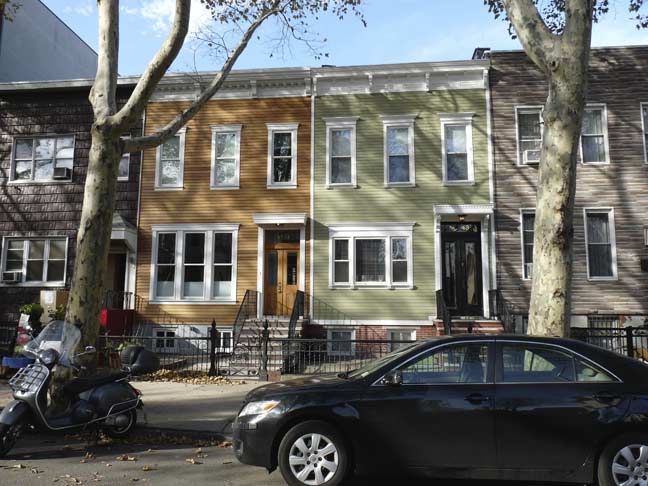
North side of Orient Avenue. If this is aluminum siding it’s a pleasant color, looks like clapboard. These people are proud of where they live.
A rhomboid-shaped plot is formed by Metropolitan and Orient Avenues that has never been anything other than a public space since 1896 when Orient Avenue was being developed.
The small diamond-shaped parcel at the corner of Orient and Metropolitan Avenues was sold for $2500 to the City of Brooklyn in 1896. It was graded and fenced for use as a park by 1897 and named for Peter Cooper, whose glue factory once stood nearby. According to the 1918 Annual Report of the Brooklyn Department of Parks, there were facilities for tennis (most likely a lawn and a net that could be easily installed and removed) at this tiny park in the 1910s. The park preserves its late-1930s improvements of new oriental plane trees, concrete paths, and wrought iron picket fence.
This park was originally known as Cooper Gore. Orient Grove’s new name refers to Orient Avenue. The street may have been so called for its location to the east of Bushwick Avenue, or the street name might nod to the definition of orient as “bright or shining.” The word “grove” derives from the Old English “graf” meaning a small stand of trees or wood without dense undergrowth. NYC Parks
So, the house numbering on the north side, or “odd side” of Orient begins at Metropolitan Avenue, while on the south side, the “even side” house numbering begins at the east end of Orient Grove, hence the disparity on the north and south sides of the street.
Other “gores” in Brooklyn include Cuyler (at Fulton and Cumberland Streets and Greene Avenue in Fort Greene) , Grant (at Bedford Avenue, Rogers Avenue and Bergen Street, where there’s a statue of Ulysses S. Grant on horseback).
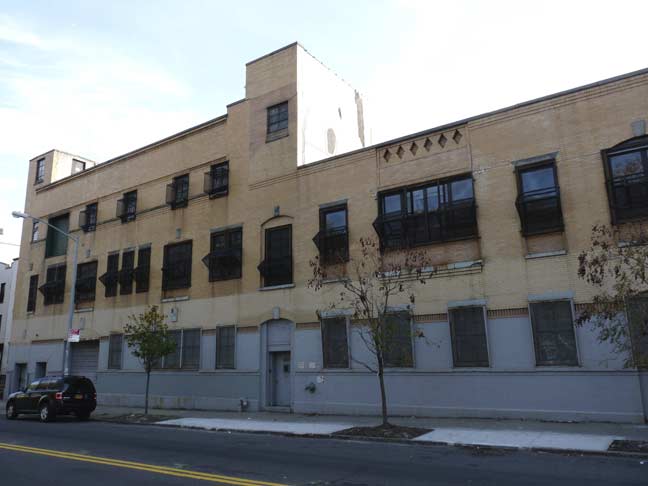
This former milk processing plant on Metropolitan Avenue opposite Orient Grove awaits redevelopment.

By all accounts, once I’m south of Metropolitan I’m no longer in Greenpoint no matter who you consult. Heading south on busy Bushwick Avenue, an English transliteration of the Dutch Boswijck, “town in the woods,” pronounced something like bos-why-ck.
The ancient painted ad for Delco/Capitol Auto Parts and Gabriel shock absorbers on Devoe Street east of Bushwick Avenue has been here since I started coming around to photograph FNY in 1998, and from the looks of things, much longer than that. Some local muralists have added a personal touch.
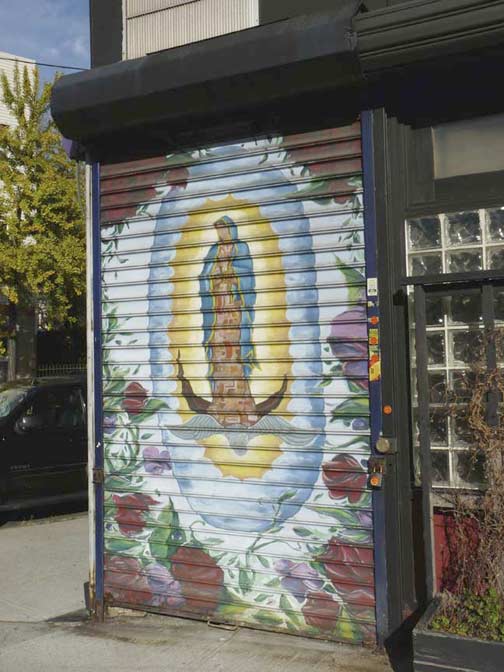
Devotional art on the corner of Bushwick and Devoe.
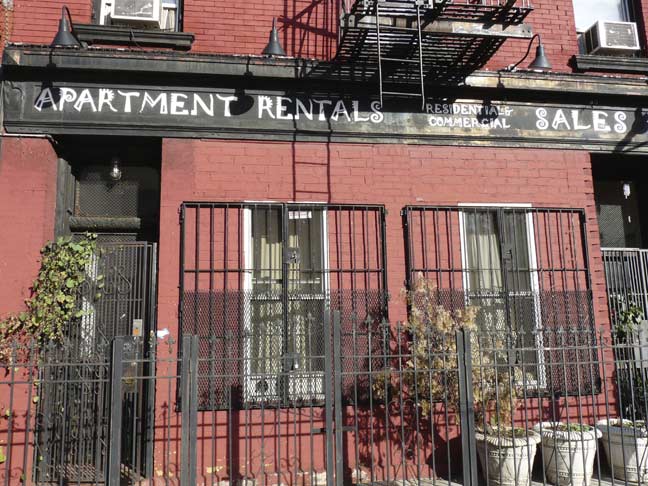
Handpainted doorway sign on Bushwick Avenue one door away. Note the gates and window bars, though, on an otherwise attractive red brick building.
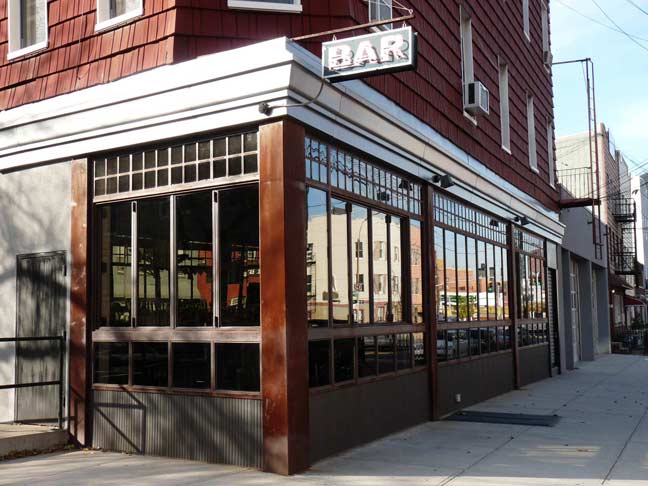
A glass-walled tavern on the corner of Bushwick and Ainslie is identified only by the neon “Bar” sidewalk overhang. From Google Maps I leaned this is actually called Matt Torrey’s, which gets a lot of 5-stars in yelp.com.
I do have a suspicion about institutions that dispense with signage, as they seem to want to appeal to only a select few who know about them.
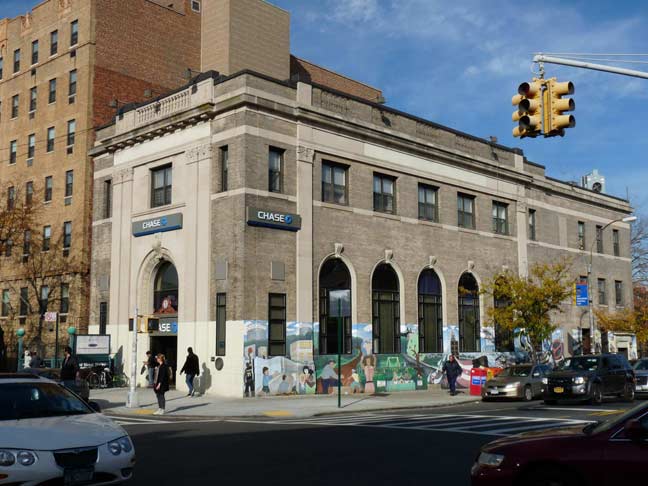
The Chase bank at Bushwick Avenue and Grand Street contains a well-maintained ground floor mural that contains a hidden historic image from East Williamsburg…
The mural contains several striking images. Raindrops embazoned with peace symbols drop from the heavens to extinguish sticks of dynamite marked “crime,” violence,” “drugs.” Adam and Eve play in a sandbox.
The mural dates to 1994, when this bank was a Chemical branch. Pfizer, named on the legend, is closing down its Williamsburg plant.
But the most fascinating item…for your webmaster at least…is the two large checkerboard topped tanks. These were the Maspeth Avenue gas tank towers…
… which, having outlived their usefulness to KeySpan (now National Grid), were imploded by explosive charges in July 2001. tanks photo: the late Bernard Ente

Before East Williamsburg and Bushwick became hipsterfied and later, generally yuppified, there was the Bushwick Hotel, really a motel, on Bushwick and Stagg Street, opposite the Williamsburg Houses.
Offering everything you could possibly desire from a hotel, ranging from extended stay reservations for those brave souls who kneel before the great literary figures found in the myriad works of Hemingway and Steinbeck (who amongst us has not yearned for the freedom of those transient workers following the harvests en route to the the great golden future of Santa Fe?), to very reasonable hourly rates for those looking to take a quick prostitute and crank fueled catnap amidst the pleasant aroma of antiseptic, all while wrapped in the very unique plastic sheets. I lay my head upon the pillow (a very reasonable $6 deposit) and suddenly I am transported to a dangerous sexual re-awakening not seen since Bernardo Bertollucci’s Last Tango in Paris. –-from a hilarious Tumblr review
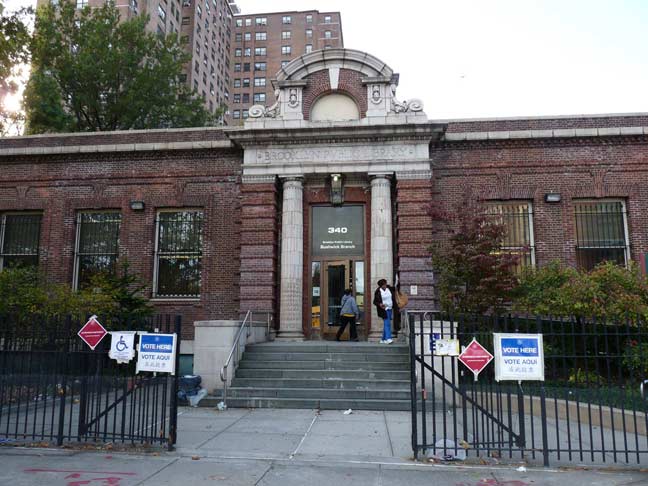
Skipping a few blocks south, the Bushwick branch of the Brooklyn Public Library sits at a bend in the road at Seigel Street across from PS 112. The handsome, Doric-columned building was part of the Andrew Carnegie library philanthropy program:
The Bushwick branch library, at the corner of Bushwick and Siegel St. was opened in 1908… when that area was heavily populated by Italian and Jewish immigrants. Before 1903 the Bushwick branch was run out of rented space in a church on Humbolt St. between Johnson and Montrose Avenues. The church burned down in 1903, and the library moved to Siegel St. and soon after into its new building. The building’s architect was Raymond Almirall, who designed the Prospect Park branch and drew up the designs for the original Central library. —Block Magazine
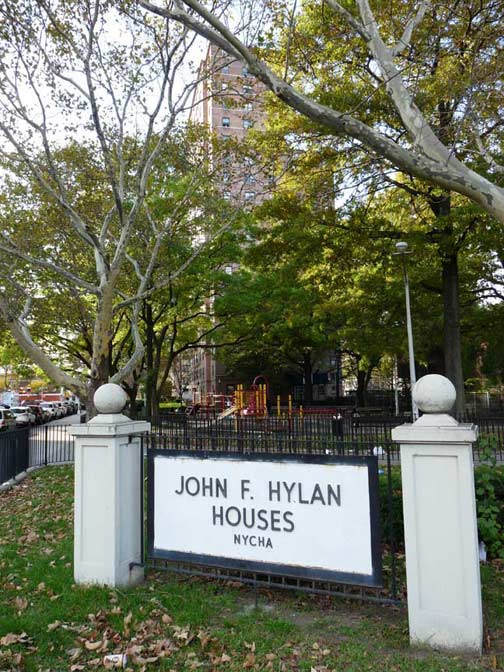
The adjoining John F. Hylan Houses were named for the NYC Mayor between 1918 and 1925. Hylan resided in Bushwick for many years in a n attached house on Bushwick Avenue that still stands. He was defeated for reelection in 1925 by Jimmy Walker. His most visible legacy is in Staten Island, whose lengthiest street was named for him in the 1920s. The housing project was completed in June 1960.
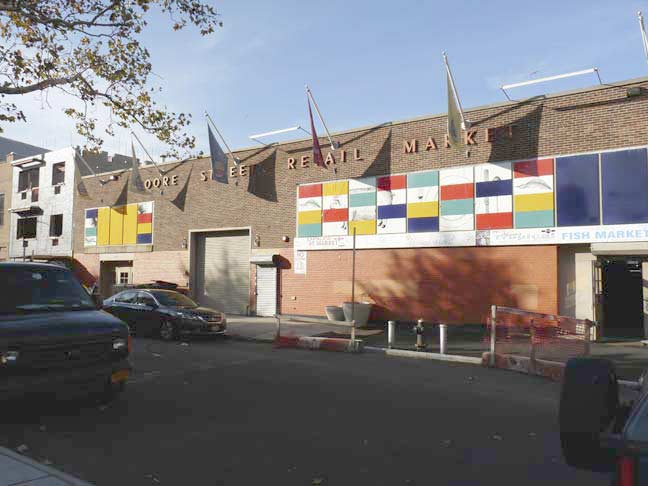
The Moore Street Retail Market is a LaGuardia-era establishment on Humboldt Street, stretching from Moore to Varet Streets.
Filled with produce vendors, small food stalls, crafts-makers and other shops, this 15,000-square-foot shopping hall is one of just four public markets left in the city. Though it was half-empty and slated for demolition in 2007, in recent years the Brooklyn Economic Development Corporation has given the market new life, securing a slew of new vendors and a makeover that includes a weekend flea market and a community garden raising tilapia. NY Daily News
NYC’s other such retail markets can be found on 13th Avenue in Borough Park, 1st Avenue in the East Village and Essex Street on the Lower East Side. When first conceived they were supposed to be a way to get pushcarts off the streets!
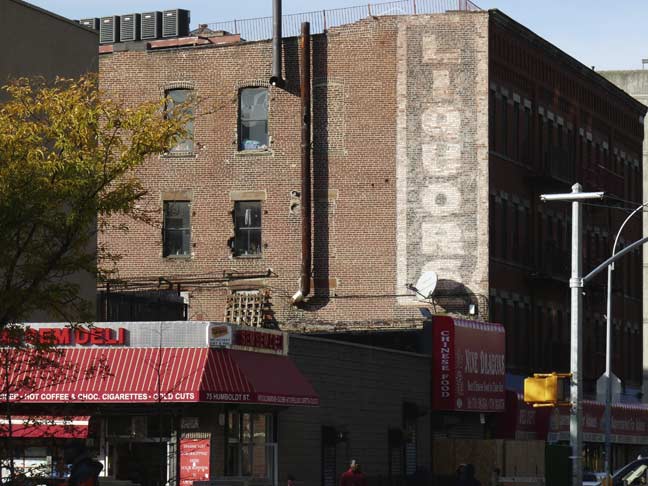
“Liquors” painted sign visible from Humboldt and Moore. It sits above a Chinese takeout palace.

Katz Drugs, Graham Avenue near Moore, has retained its classic green vinyl/colored neon sign. Since ‘farmacia’ is good in both Spanish and Italian, I wonder which language the sign is supposed to be in. According to NY Neon the sign was built by the Silverescent Neon Sign Co., circa 1955.
I have dealt with Moore Street’s interesting signs before, but here’s one that wasn’t visible behind a party goods awning sign in 2011. Young One Shoes Center, which also dealt in sporting goods, was being repurposed in October 2014 when I shot the photos.

The side wall on Moore Street was being greenwashed.
Colorful weather-themed wall mural on Moore west of Graham. I think it’s making a point about global warming, since the chart goes to 2060, but danged if I can figure how to read it.
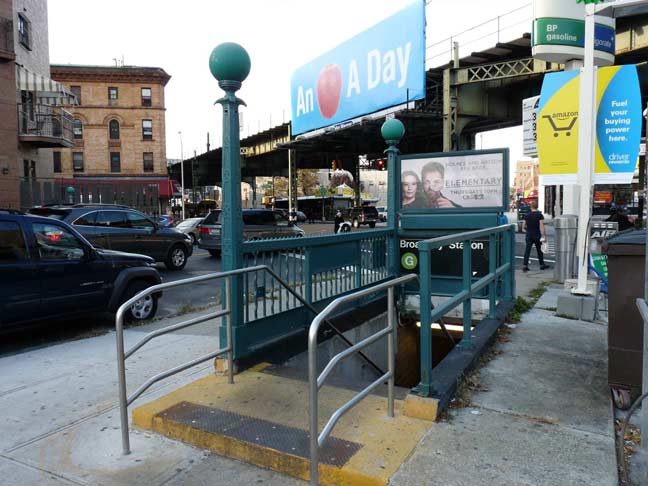
Time to kick the Greenpoint walk in the head for the day, though I’m seemingly there every few weeks or so. This is the Broadway G train station at Union Avenue, and since a free transfer from the G to the 7, E and M was instituted at Court Square in Queens it’s a very convenient train, even at just 4 cars in the trainset.
The MTA generously provided that Court Square transfer, but is stingier about a transfer from here to the nearby J and M on Broadway. Nothing planned for that.

Spelling was better taught in the 1930s, but this mistake has been here since the line opened during the decade. In fact, there were plans to fix it a few years ago but it’s become a beloved icon, so the MTA relented.
1/4/15


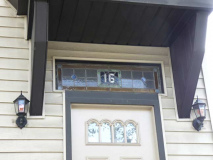
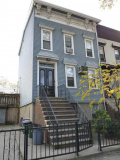
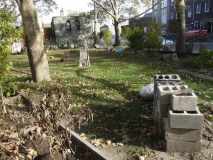
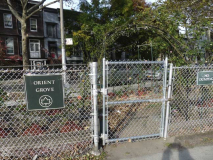
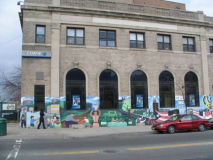

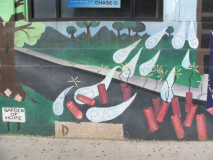
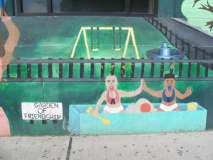

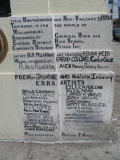
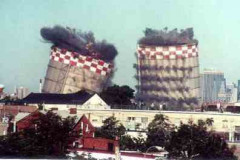
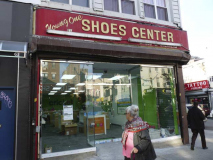
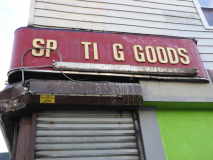
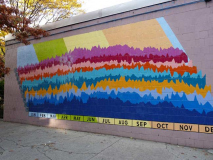
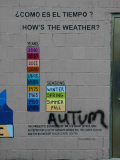

1 comment
I was in the Moore St Market in November (while searching for what’s left of Cook St); it seemed quite underutilized. Regarding other 1930s LaGuardia-era markets, you omitted the very well utilized market on Arthur Ave in the Bronx. The former market at 10th St & 1st Ave is now an arts center, I don’t recall any retail there (but I might have missed some) when I was there a couple of years ago, but at least the building exterior is extant.